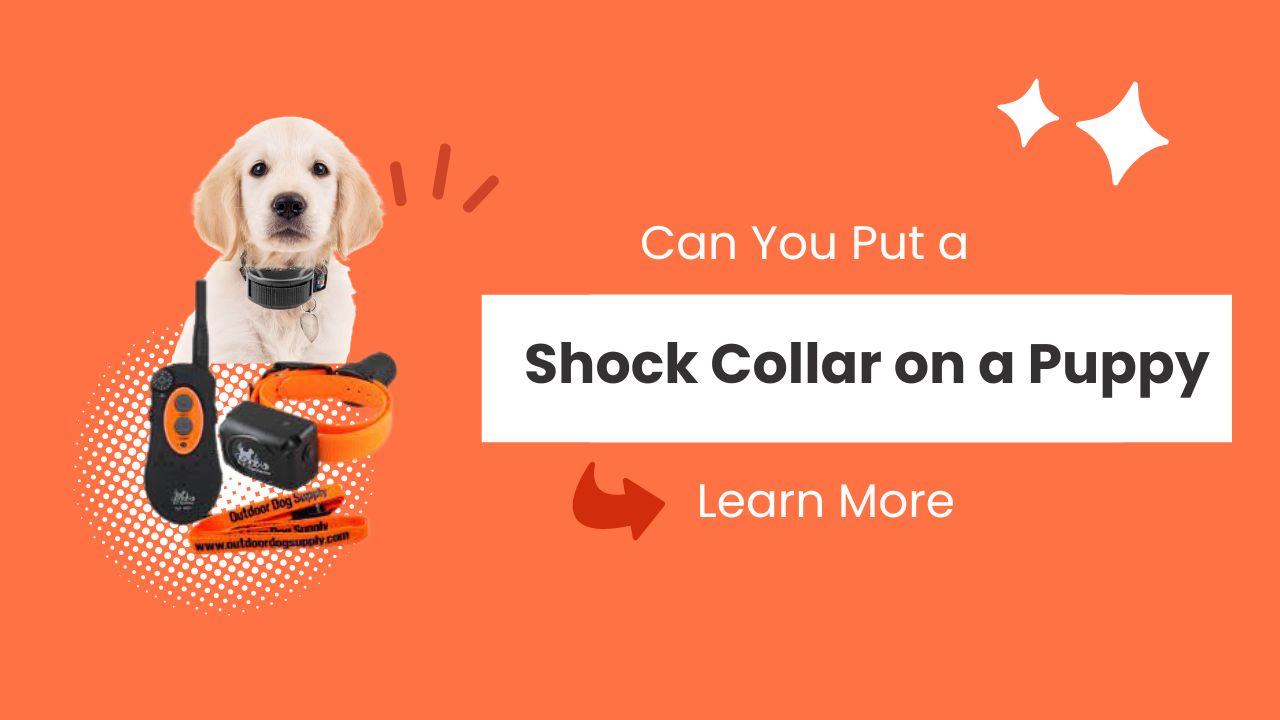Bringing home a new puppy is a joyous experience, filled with excitement and anticipation. As a responsible and caring puppy owner, you want the best for your furry friend, including effective and humane training methods. One common question that arises is whether it’s appropriate to use a shock collar on a puppy.
In this blog post, we will explore the topic Can You use Shock Collar on Puppy, examining various training methods also pros and cons. So let’s get started.
Shock collars are devices that deliver electric shocks to the dog’s neck as a form of punishment or reinforcement during training.
What You’ll Learn:
In this guide, we’ll cover everything you need to know about using shock collars on puppies.
By the end of this article, you’ll gain a clear understanding of shock collar for puppies.

What Are Shock Collars?
Shock collars are electronic devices designed to provide a corrective stimulus, often a static shock, to a dog wearing the collar.
Some collars can be remotely controlled by the owner, while others may have automatic triggers based on the dog’s behavior.
The intensity of the shock can usually be adjusted, but the use of such collars remains controversial.
Shock Collar Working Process
Shock collars, work by delivering a mild electric sensation to a dog’s neck when triggered by a remote control.
- The collar contains electronic components that produce the sensation.
- When the owner or trainer presses a button on the remote, a signal is sent to the collar, which releases a small electric shock.
- The intention is to provide immediate feedback to the dog, linking certain behaviors with the mild discomfort of the shock.
Can You Use Shock Collar on Puppy?
Experts generally advise against using shock collars on puppies. Puppies are at a crucial stage of development, physically and emotionally, and subjecting them to electric shocks can cause fear, anxiety, and potential harm. Positive reinforcement training is recommended instead.
Use of shock collar is the end tool to use, so based on our research, if you are considering using a shock collar for puppies, it is crucial to wait until the puppy is at least 3-4 months old. Puppies at this age are more physically and mentally developed, making them better suited to handle any mild sensations the collar may produce.
According to Canine Journal shock collars should not be used as a form of punishment. Instead, they can be used as a tool to interrupt undesirable behaviors or prevent puppies from engaging in actions that could be potentially harmful or interfere with their training
Pros:
- Quick results: Some proponents of shock collars argue that they deliver fast results, leading to behavioral changes in puppies.
- Remote Training: The ability to control the collar from a distance can be useful for reinforcing commands or correcting behavior, even when the owner is not physically close to the puppy.
Cons
- Potential for fear and anxiety: Shock collars can induce fear and anxiety in puppies, leading to negative associations with training and even people or environments.
- Risk of physical harm: Puppies are more delicate than adult dogs, and the intensity of the shock may cause physical harm or exacerbate existing health conditions.
- Ineffective for positive learning: Shock collars may suppress undesirable behavior temporarily, but they do not teach puppies what they should do instead, potentially hindering their overall learning experience.
Shock Collar Alternatives: Humane Training Methods for Dogs
- Positive Reinforcement Training: Utilize rewards like treats, praise, or toys to reinforce desired behaviors, encouraging your dog to repeat them. This method builds trust and strengthens the bond between you and your furry companion.
- Clicker Training: Clicker training uses a clicking sound to mark correct behaviors, followed by rewards. This clear communication helps dogs understand the desired actions, making learning more effective and enjoyable.
- Verbal Cues and Body Language: Use consistent verbal commands and body language to communicate with your dog. Clear signals and cues help convey your expectations and guide their behavior without the need for aversive methods.
- Leash Training with Harness or Head Collar: Opt for a harness or head collar to walk your dog comfortably and gently. These alternatives provide better control and prevent pulling without causing discomfort or pain.
- Interactive Play and Mental Stimulation: Engage your dog in interactive games and puzzles to stimulate their mind and expend energy positively. Mental enrichment reduces unwanted behaviors and keeps your dog content.
FAQs | About Shock Collars and Puppy Training:
Q1: Can shock collars be used for training any breed?
A1: While shock collars can technically be used on various breeds, their effectiveness and appropriateness vary widely. Breed-specific traits and individual temperament should be considered when choosing a training method.
Q2: How long does it take to train a puppy using positive reinforcement?
A2: The training period can vary depending on the puppy’s age, breed, and temperament. Consistent positive reinforcement training can yield noticeable results in a few weeks.
Q3: What are the alternatives to shock collars for puppy training?
A: Positive reinforcement training using treats, praise, and patience is a safe and effective alternative to shock collars for puppy training.
Remember, a well-trained and happy puppy is the result of patience, love, and positive training methods. By choosing positive reinforcement techniques, you can create a harmonious and trusting relationship with your puppy, ensuring a lifetime of joyous companionship.


